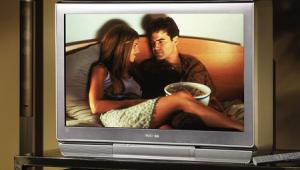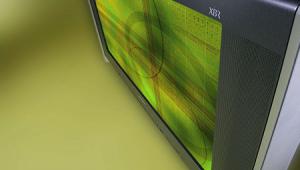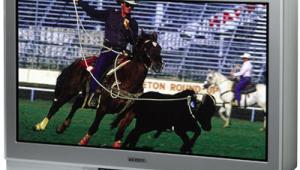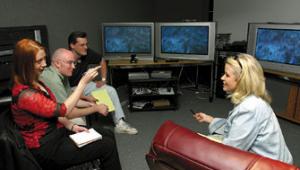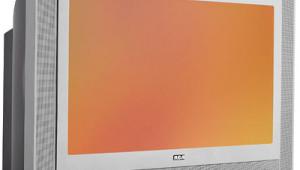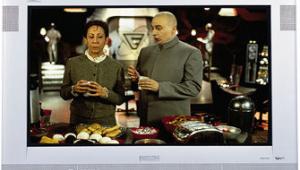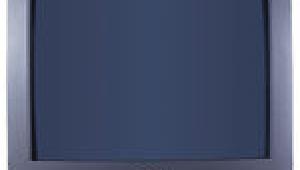Philips 34PW9818 16:9 HD-ready direct-view monitor
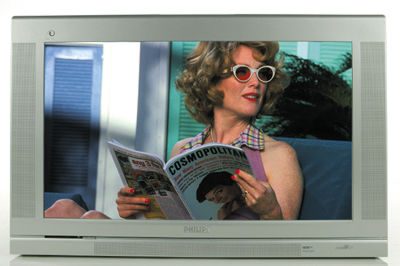
Finally, there's the quality of the HDTV's upconversion. Some HD sets do such a poor job of this that older analog big screens can actually look better—a real shock to someone who's shelled out thousands for an HD-ready set.
At CES 2002, Philips demonstrated Pixel Plus, a resolution-enhancing process for NTSC-based broadcast, satellite, and interlaced DVD. The company touted the new circuit as delivering "near high-definition" picture quality. PixelPlus converts 480i to 960i and doubles the number of "pixels" in each horizontal line from 1024 to 2048. In the demo I saw, the push of a button split the screen in half: The left side reverted to unprocessed 960i (or simple line doubling), while the right side remained PixelPlused. The difference was remarkable. The unprocessed side looked fuzzy and blurred, the PixelPlus side sharp and clear. Philips is so high on PixelPlus that they've included this demo in the operating software of the 34PW9818—push a button on the set's universal remote, and the buyer can the see the difference PixelPlus makes. Does it almost level the playing field between HDTV and NTSC? Read on!
Features Galore, One Glaring Omission
The 34PW9818 is Philips' replacement for the 34PW9817, which I reviewed in the October 2001 SGHT. The new set features subtle but satisfying improvements in industrial design. The silver faceplate is more cleanly rendered, leaving room for a new, built-in center-channel speaker below the Philips logo, along with the stereo pair on either side of the screen. More important, the rear panel now includes two sets of high-bandwidth component-video inputs instead of one, and one of these offers a multi-pin VGA input for use with computers, RCA's now-discontinued DTC-100 HD DirecTV set-top box, or any newer STBs similarly equipped. There's an additional 480i component-video input, as well as one input with S-video and composite. There's still only one antenna input, which, in today's world of broadcast and cable, should suffice. A side-mounted S-video/composite-video/analog-audio input allows for easy analog camcorder or video-game connection.
Inexplicably missing from the 34PW9818 is a DVI connector, which will be a deal-breaker for some prospective buyers. If you're not really interested in HDTV and just want a widescreen digital set to watch DVDs on, no problem. If you're concerned about the possibility that, one day, the component-video outputs of HD STBs will be "downrezzed" to 480p by content providers, this omission is a big problem. Most industry observers don't believe that will ever happen, because the result could be an expensive class-action lawsuit or federal legislation to protect the rights of the millions of consumers who already own non–DVI-equipped HD sets. Still, the bottom line is that there is at least some risk involved in buying a non-DVI set.
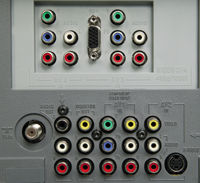 The 34PW9818 includes a dizzying list of video and audio features, including PixelPlus, progressive scan with 3:2 pulldown (which Philips calls Digital Natural Motion), three color-temperature presets, dynamic contrast, noise reduction, color enhancement, and automatic picture controls. I left all of these off while assessing picture quality. There are six aspect-ratio settings, including the very useful Wide Screen, which leaves the center untouched while subtly stretching the sides to fill the screen. Unfortunately, there is no aspect-ratio control for the high-bandwidth inputs (they're fixed to the mode appropriate for anamorphic DVDs and widescreen DTV). There are picture-in-picture (PIP) facilities for up to six channels in addition to the main one being watched. Audio accoutrements include a five-band equalizer, simulated surround sound, and Dolby Pro Logic (including test-tone and level-trim facilities), with provisions for adding a pair of surround speakers. There's even a built-in "subwoofer."
The 34PW9818 includes a dizzying list of video and audio features, including PixelPlus, progressive scan with 3:2 pulldown (which Philips calls Digital Natural Motion), three color-temperature presets, dynamic contrast, noise reduction, color enhancement, and automatic picture controls. I left all of these off while assessing picture quality. There are six aspect-ratio settings, including the very useful Wide Screen, which leaves the center untouched while subtly stretching the sides to fill the screen. Unfortunately, there is no aspect-ratio control for the high-bandwidth inputs (they're fixed to the mode appropriate for anamorphic DVDs and widescreen DTV). There are picture-in-picture (PIP) facilities for up to six channels in addition to the main one being watched. Audio accoutrements include a five-band equalizer, simulated surround sound, and Dolby Pro Logic (including test-tone and level-trim facilities), with provisions for adding a pair of surround speakers. There's even a built-in "subwoofer."
Performance Plus
Using the 34PW9818 was a pleasure, thanks to its well-designed backlit remote and its reasonably easy-to-use but busily animated, videogame-like menu system—the same one used in the 34PW9817.
The post-calibration numbers pointed to superb hi-def picture performance, within the resolution limitations of a 34-inch-diagonal screen (see sidebar, "Calibration"). From both over-the-air HDTV—which, in the New York City area, is still available only from CBS (due to the collapse of the World Trade Center)—and my growing library of hi-def D-VHS tapes, the picture quality offered by the 34PW9818 when viewed from normal distances left little to be desired. Blacks were pitch-dark, and the subjective contrast ratio was excellent. Detail and depth were superb. The picture was stable and free of video noise.
- Log in or register to post comments
